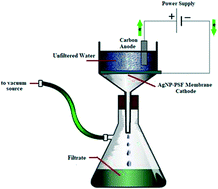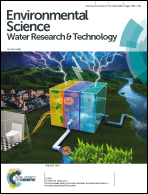Anti-biofilm AgNP-polyaniline-polysulfone composite membrane activated by low intensity direct/alternating current
Abstract
Biofouling is a serious problem in membrane bioreactor systems, which reduces membrane permeability, increases energy costs, and decreases the lifetime of membranes. This study developed and evaluated a conductive ultrafiltration membrane activated by electric current for biofilm control. The polysulfone(PSF)-based membrane was incorporated with polyaniline (PANI) and silver nanoparticles (AgNPs) as the electrical conductivity enhancer and the antimicrobial agent, respectively. Compared to the bare PSF membrane, the AgNP-PANI-PSF membrane showed lower porosity but higher surface hydrophilicity. The membranes were connected to power sources providing either direct current (DC) or alternating current (AC) at an intensity level of 60 μA. The AgNP-PANI-PSF membrane activated by electric current (DC and AC) effectively prevented bacterial colonization by six orders of magnitude, and limited the silver leaching under 0.1 mg L−1 after 24 hour tests. The AC activation maximized the anti-biofilm efficacy of the AgNPs, and the DC activation minimized the silver loss from the membrane. This study indicated that the electrically-activated AgNP-PANI-PSF membrane can be further developed as an alternative solution for membrane fouling control.



 Please wait while we load your content...
Please wait while we load your content...